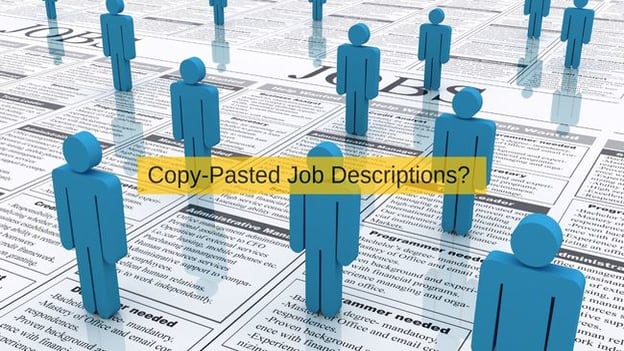Why copy-pasting job descriptions hurts your hiring: 5 key reasons to avoid it

When it comes to job descriptions, we've all had that ‘wait a minute, I've seen this before’ feeling. With a few tweaks here and there, the same old adjectives and tone seem to reappear across different brands. As experts in the hiring field, we understand the importance of crafting captivating job descriptions that clearly convey the role's requirements and responsibilities. However, it's a trap many organisations fall into—copying generic job descriptions from the internet or relying on outdated templates.
In a world where the job market is tighter than ever, taking shortcuts with your company's brand is a risky move. We all know it's tempting to copy and paste job descriptions, but trust us, it can have serious consequences. So, buckle up and let us enlighten you on why copying job descriptions is a recipe for disaster when it comes to attracting top talent and filling open roles.
1. Lack of differentiation
Picture this: you stumble upon a job description that could be for any company out there. It's so generic that it lacks any hint of the organisation's unique culture, values, and goals. Now, put yourself in the shoes of a potential candidate. Would you be excited about joining a company that appears mundane and uninteresting?
When you copy job descriptions, you miss a golden opportunity to showcase what makes your company stand out. Let's say you have a fun-loving work environment where employees enjoy regular team-building activities and traditions. By copying a generic description, you're robbing candidates of the chance to see that your office might just be the perfect place for them to thrive.
Remember, now more than ever, top talent wants more than just a paycheck. They seek a company that aligns with their values and offers an environment that stimulates their passion. When your job description fails to capture your unique essence, you risk losing those star candidates to competitors who know how to showcase their distinct culture.
2. Misalignment with actual role
You're in a rush to fill a position, so you hurriedly copy a job description that doesn't quite align with your organisation's needs. What happens next? You end up with a candidate who looked perfect on paper but turns out to be as out of place as a penguin in a desert. Let's dive into an example to understand this: You're seeking a product manager. Instead of crafting a job description that captures the unique challenges and employee-centric approach of your company, you opt for a generic template that fails to grasp the true essence of the role. As a result, you may hire someone who lacks the necessary empathy and problem-solving skills required to excel in your employee-focused environment.
When responsibilities and requirements are out of sync, chaos ensues. High turnover rates, dissatisfied employees, and wasted resources become the unfortunate aftermath of this mismatched hiring. You may find yourself stuck with employees who feel overwhelmed or disengaged because they were misled by a generic job description that didn't accurately portray the reality of the role.
That's why it's crucial to craft job descriptions tailored to your organisation's unique needs. By highlighting the specific skills, qualities, and experiences that align with your company's values and expectations, you'll increase your chances of finding candidates who not only meet the stated responsibilities but also thrive in their roles. This, in turn, leads to higher job satisfaction and improved retention rates.
3. Missed opportunity for innovation
Let’s say, you're hiring for a tech-savvy role. Instead of crafting a job description that showcases your organisation's hunger for innovation and embraces the latest industry trends, you settle for a static, cookie-cutter template that belongs in a time capsule. This means you might miss out on candidates who possess the forward-thinking mindset and adaptability needed to tackle new challenges head-on. When job descriptions become stagnant, the entire hiring process suffers. You lose the ability to attract top talent who are eager to bring fresh perspectives, skills, and technologies to your organisation.
Your competitors, on the other hand, are busy crafting dynamic job descriptions that captivate the imagination of innovative candidates. So, don't let your job descriptions collect dust! Embrace the power of evolution. Let them be living documents that reflect your organisation's changing needs and embrace industry trends. Infuse them with new ideas, skills, and technologies to attract candidates who thrive on innovation. With dynamic job descriptions, you'll unlock the potential to build a team that can adapt, innovate, and stay ahead of the curve.
4. Poor candidate experience
An inadequately designed job description has the potential to generate an unfavourable impression on candidates. When individuals encounter a generic and unstimulating job description, they might feel that your organisation lacks innovation or fails to place importance on recruiting top talent. As a result, highly qualified candidates may be discouraged from applying, resulting in a limited selection of applicants for you to choose from. Furthermore, a negative candidate experience can have a detrimental impact on your company's reputation, making it more difficult to attract potential candidates in the future.
Things to avoid:
- A job description that simply lists the responsibilities without showcasing the unique aspects of the role or the company's culture may make potential candidates assume the organisation lacks creativity and excitement.
- Using generic terms and clichés like ‘team player’ or ‘self-starter’ without providing specific examples or context can make the job description seem uninspiring and unoriginal, deterring highly qualified candidates.
- If the job description lacks details about growth opportunities, training programs, or employee benefits, candidates might perceive that the organisation doesn't prioritise talent development, leading them to look for other opportunities.
5. Delay in screening
Imagine a healthcare organisation seeking a nurse practitioner for a specialised department, but the job description provided is a generic one for general nursing positions. As a consequence, numerous applications flood in from registered nurses who lack the advanced qualifications and experience needed for the specialised role. Both the recruitment team and the candidates have to invest significant time and effort in the screening process, unnecessarily prolonging the hiring timeline.
When using duplicated job descriptions, there is a likelihood of receiving numerous applications from applicants who lack the necessary qualifications. Vague descriptions typically fail to provide the detailed information needed to sift out individuals who do not meet the required criteria in terms of skills or experience. Consequently, this leads to wasted time and effort for both recruiters and candidates who must endure a time-consuming screening process that could have been avoided with a more customised job description.
Stay tuned to People Matters for more information on job postings.










